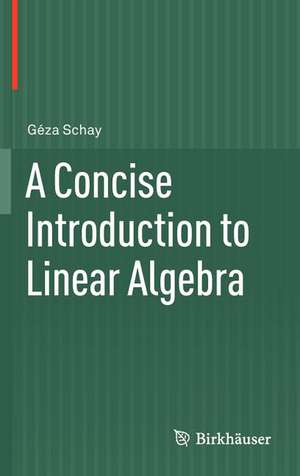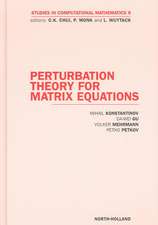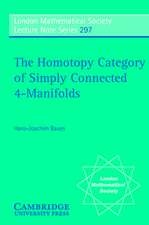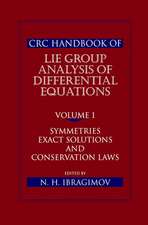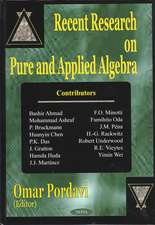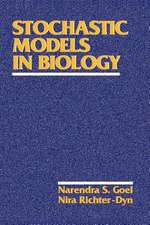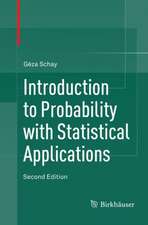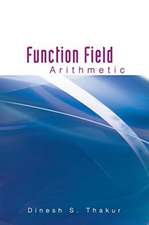A Concise Introduction to Linear Algebra
Autor Géza Schayen Limba Engleză Hardback – 30 mar 2012
The focus throughout is rooted in the mathematical fundamentals, but the text also investigates a number of interesting applications, including a section on computer graphics, a chapter on numerical methods, and many exercises and examples using MATLAB. Meanwhile, many visuals and problems (a complete solutions manual is available to instructors) are included to enhance and reinforce understanding throughout the book.
Brief yet precise and rigorous, this work is an ideal choice for a one-semester course in linear algebra targeted primarily at math or physics majors. It is a valuable tool for any professor who teaches the subject.
Preț: 479.87 lei
Preț vechi: 564.55 lei
-15% Nou
Puncte Express: 720
Preț estimativ în valută:
91.83€ • 96.31$ • 76.44£
91.83€ • 96.31$ • 76.44£
Carte tipărită la comandă
Livrare economică 01-15 aprilie
Preluare comenzi: 021 569.72.76
Specificații
ISBN-13: 9780817683245
ISBN-10: 0817683240
Pagini: 330
Ilustrații: XII, 330 p. 50 illus.
Dimensiuni: 155 x 235 x 21 mm
Greutate: 0.66 kg
Ediția:2012
Editura: Birkhäuser Boston
Colecția Birkhäuser
Locul publicării:Boston, MA, United States
ISBN-10: 0817683240
Pagini: 330
Ilustrații: XII, 330 p. 50 illus.
Dimensiuni: 155 x 235 x 21 mm
Greutate: 0.66 kg
Ediția:2012
Editura: Birkhäuser Boston
Colecția Birkhäuser
Locul publicării:Boston, MA, United States
Public țintă
Upper undergraduateCuprins
Preface.- 1 Analytic Geometry of Euclidean Spaces.- 2 Systems of Linear Equations, Matrices.- 3 Vector Spaces and Subspaces.- 4 Linear Transformations.- 5 Orthogonal Projections and Bases.- 6 Determinants.- 7 Eigenvalues and Eigenvectors.- 8 Numerical Methods.- 9 Appendices.
Recenzii
From the reviews:
“This book … gives a well written presentation of linear algebra mainly for physics and computer science students. … mathematics majors will benefit as well, due to its clearness and inclusion of several examples and problems. The problems can be approached by the average student. The presentation is quite standard and begins from analytic geometry of Euclidean spaces, and then systems of equations -- matrices.” (A. Arvanitoyeorgos, Zentralblatt MATH, Vol. 1242, 2012)
“This book … gives a well written presentation of linear algebra mainly for physics and computer science students. … mathematics majors will benefit as well, due to its clearness and inclusion of several examples and problems. The problems can be approached by the average student. The presentation is quite standard and begins from analytic geometry of Euclidean spaces, and then systems of equations -- matrices.” (A. Arvanitoyeorgos, Zentralblatt MATH, Vol. 1242, 2012)
Textul de pe ultima copertă
This book offers a refreshingly concise, manageable introduction to linear algebra: Whereas most treatments of the subject give an exhaustive survey supplemented with applications, this book presents a carefully selected array of the most essential topics that can be thoroughly covered in a single semester.
The exposition generally falls in line with the material recommended by the Linear Algebra Curriculum Study Group, but notably deviates in providing an early emphasis on the geometric foundations of linear algebra. Starting with vectors, lines, and planes in two and three dimensions gives students a more intuitive understanding of the subject and enables an easier grasp of more abstract concepts. Two important pedagogical devices are also directed to this end: First, throughout the book, the notation is carefully selected to indicate the connections between related quantities; second, in addition to numbering, brief mnemonic titles are appended to theorems and examples, making it easier for the student to internalize and recall important concepts (e.g., it is much more satisfying to recall the Dimension Theorem than to recall Theorem 3.5.1).
The focus throughout is primarily on fundamentals, guiding readers to appreciate the elegance and interconnectedness of linear algebra. At the same time, the text presents a number of interesting, targeted applications, offering a glimpse of how the subject is used in other fields, especially in physics. A section on computer graphics and a chapter on numerical methods also provide looks at the potential uses of linear algebra, and most sections contain exercises using MATLAB® to put theory into practice in a variety of contexts. Visuals and problems are included to enhance and reinforce understanding throughout the book, and both students’ and instructors’ solutions manuals (for non-MATLAB exercises) are available online.
A Concise Introduction toLinear Algebra builds on the author's previous title on the subject (Introduction to Linear Algebra, Jones & Bartlett, 1996). With brevity, precision, and rigor, the work is an ideal choice for a standard one-semester course targeted primarily at math or physics majors. It is a valuable addition to the book collection of anyone who teaches or studies the subject.
The exposition generally falls in line with the material recommended by the Linear Algebra Curriculum Study Group, but notably deviates in providing an early emphasis on the geometric foundations of linear algebra. Starting with vectors, lines, and planes in two and three dimensions gives students a more intuitive understanding of the subject and enables an easier grasp of more abstract concepts. Two important pedagogical devices are also directed to this end: First, throughout the book, the notation is carefully selected to indicate the connections between related quantities; second, in addition to numbering, brief mnemonic titles are appended to theorems and examples, making it easier for the student to internalize and recall important concepts (e.g., it is much more satisfying to recall the Dimension Theorem than to recall Theorem 3.5.1).
The focus throughout is primarily on fundamentals, guiding readers to appreciate the elegance and interconnectedness of linear algebra. At the same time, the text presents a number of interesting, targeted applications, offering a glimpse of how the subject is used in other fields, especially in physics. A section on computer graphics and a chapter on numerical methods also provide looks at the potential uses of linear algebra, and most sections contain exercises using MATLAB® to put theory into practice in a variety of contexts. Visuals and problems are included to enhance and reinforce understanding throughout the book, and both students’ and instructors’ solutions manuals (for non-MATLAB exercises) are available online.
A Concise Introduction toLinear Algebra builds on the author's previous title on the subject (Introduction to Linear Algebra, Jones & Bartlett, 1996). With brevity, precision, and rigor, the work is an ideal choice for a standard one-semester course targeted primarily at math or physics majors. It is a valuable addition to the book collection of anyone who teaches or studies the subject.
Caracteristici
A uniquely concise, focused, and rigorous study of linear algebra for beginners Integrates a variety of applications without distracting from the elegance and interconnectedness of theory Offers a wealth of exercises, many using MATLAB, and a complete solutions manual Provides many precise illustrations to enhance clarity Notation integrates seamlessly with future courses students can expect to take Includes supplementary material: sn.pub/extras Request lecturer material: sn.pub/lecturer-material
